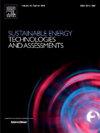A review on unleashing the potential solution of thermal comfort: Exploring the cutting-edge progress of advanced engineering application of phase change materials integrated textiles
IF 7.1
2区 工程技术
Q1 ENERGY & FUELS
Sustainable Energy Technologies and Assessments
Pub Date : 2024-11-19
DOI:10.1016/j.seta.2024.104089
引用次数: 0
Abstract
Conventional fabrics often fail to regulate temperature effectively, leading to discomfort for the wearer. Under fluctuating environmental conditions, the discomfort in textiles may pose a challenge, specially, in outdoor apparel; sportswear and healthcare. Phase Change Materials (PCMs), have emerged as a game-changer in textile engineering due to the pursuit of novel solutions in the realm of thermal comfort. Owing to their abilities of absorbing, storing, and releasing heat during phase transitions, PCMs provide a more controlled thermal environment. PCMs, considered as excellent contenders for thermal energy storage as they can store and release latent heat energy over a narrow temperature range and are available at various phase change transition temperatures. This review explores the integration of PCMs into textiles, known as PCMs incorporated textiles (PCMTs), which are designed to enhance thermal regulation in fabrics. The study reports a detailed classification of PCMs and textiles structures, along with an evaluation of incorporation techniques such as lamination, coating, and spinning. Analytical techniques like Differential Scanning Calorimetry (DSC), Thermogravimetric Analysis (TGA), and mechanical property assessments are thoroughly reviewed to measure the effectiveness of PCMT. Additionally, a detailed analytical study has been conducted on the categorisation of PCMT according to PCM type, textile structure, and their potential to transform thermal comfort solutions across a range of applications. Furthermore, critical research gaps and future directions for optimising PCMT for enhanced durability, breathability, and thermal regulation across a wide range of applications have also been discussed.

关于释放热舒适潜在解决方案的综述:探索相变材料集成纺织品先进工程应用的前沿进展
传统织物往往无法有效调节温度,导致穿着者感到不适。在多变的环境条件下,纺织品的不适感可能会带来挑战,尤其是在户外服装、运动服和医疗保健领域。相变材料(PCM)的出现改变了纺织工程领域的游戏规则,因为人们在热舒适领域寻求新的解决方案。由于在相变过程中具有吸收、储存和释放热量的能力,PCM 可提供更可控的热环境。PCM 可在较窄的温度范围内储存和释放潜热能量,并可在各种相变转变温度下使用,因此被视为热能储存的最佳选择。本综述探讨了如何将 PCMs 集成到纺织品中,即 PCMs 集成纺织品 (PCMT),以增强织物的热调节功能。研究报告对 PCM 和纺织品结构进行了详细分类,并对层压、涂层和纺纱等融入技术进行了评估。研究还对差示扫描量热法 (DSC)、热重分析 (TGA) 和机械性能评估等分析技术进行了深入探讨,以衡量 PCMT 的有效性。此外,还根据 PCM 类型、织物结构及其在一系列应用中改变热舒适解决方案的潜力,对 PCMT 的分类进行了详细的分析研究。此外,还讨论了在广泛应用中优化 PCMT 以提高耐用性、透气性和热调节能力的关键研究差距和未来方向。
本文章由计算机程序翻译,如有差异,请以英文原文为准。
求助全文
约1分钟内获得全文
求助全文
来源期刊

Sustainable Energy Technologies and Assessments
Energy-Renewable Energy, Sustainability and the Environment
CiteScore
12.70
自引率
12.50%
发文量
1091
期刊介绍:
Encouraging a transition to a sustainable energy future is imperative for our world. Technologies that enable this shift in various sectors like transportation, heating, and power systems are of utmost importance. Sustainable Energy Technologies and Assessments welcomes papers focusing on a range of aspects and levels of technological advancements in energy generation and utilization. The aim is to reduce the negative environmental impact associated with energy production and consumption, spanning from laboratory experiments to real-world applications in the commercial sector.
 求助内容:
求助内容: 应助结果提醒方式:
应助结果提醒方式:


